Imagine stepping outside to pluck sun-warmed berries alongside crisp greens for tonight’s dinner. This isn’t just gardening—it’s crafting a living pantry where flavor partnerships thrive. For thousands of years, cultures worldwide have paired tangy citrus with earthy herbs or juicy tomatoes with aromatic basil, proving that contrasting tastes belong together.
Today’s home growers are rediscovering this wisdom. By mixing edible varieties in shared beds, you’ll save space while boosting biodiversity. Picture plump strawberries spilling between pepper plants or apple trees shading tender lettuces. These combinations don’t just look stunning—they create ecosystems where plants support each other naturally.
Local farmers’ markets show how vibrant these pairings can be, inspiring chefs and home cooks alike. Your plot can become that same source of inspiration. Why settle for separate rows when intertwined harvests offer endless recipe possibilities? From grilled peaches with fresh arugula to zucchini blossoms stuffed with herbed cheese, your meals will celebrate what’s in season.
Ready to rethink your outdoor space? You’ll join a growing community turning yards into flavorful landscapes that nourish both body and imagination. Let’s dig into how to balance practicality with creativity, ensuring every square foot delivers delicious rewards.
Introduction to Your Fruit and Vegetable Garden
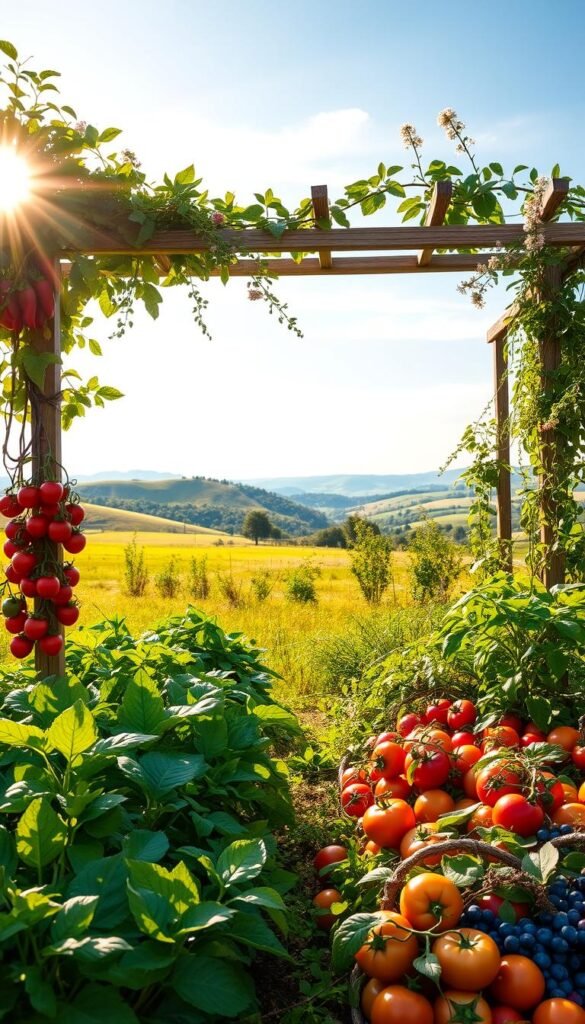
Your backyard could become a vibrant mix of flavors where every harvest tells a story. Spring markets burst with variety, offering endless inspiration for colorful meals. Growing your own ingredients means enjoying fresher food while supporting local growers—a win for your plate and community.
Discovering the Sweet and Savory Balance
Nature thrives on partnerships. Juicy strawberries nestle beside spinach, while basil guards tomatoes from pests. This isn’t just pretty—it’s smart gardening. Plants work together like puzzle pieces, improving soil and deterring bugs naturally.
Ever noticed how store-bought greens lack that crisp snap? Homegrown picks offer unmatched taste because they’re eaten hours after picking. You’ll savor the difference in every bite of sun-ripened peppers or tender herbs.
Smart plant combinations save space and money. Why buy basil when your tomato pot can grow both? Many gardeners find this approach cuts grocery bills while delivering peak nutrition.
See those overflowing market stalls? Your plot can mirror that abundance. Start small—maybe mint with peas or radishes shading carrots. Each pairing teaches you more about nature’s perfect balance.
Exploring the Rich World of Sweet and Savory Flavors
Ever wondered why cranberry sauce feels destined for turkey? Centuries of culinary experimentation reveal how contrasting flavors create magic. Elizabethan cooks spiced venison with dried plums, while French chefs perfected duck with citrus—proof that bold pairings stand the test of time.
Nature’s Flavor Chemistry
Tart apples cut through fatty pork. Berries add brightness to earthy greens. These duets work because acids and sugars balance richness. Plants evolved these traits to attract pollinators, but your kitchen reaps the rewards.
| Historical Dish | Key Ingredients | Flavor Contrast |
|---|---|---|
| English Mince Pies | Beef, Currants, Cloves | Meaty + Fruity |
| Italian Mostarda | Peaches, Mustard Oil | Sweet + Spicy |
| French Duck à l’Orange | Duck, Bitter Orange | Savory + Tangy |
Market-Stall Wisdom
Visit Saturday markets to spot winning combinations. Vendors often display figs near prosciutto or melons beside feta—clues for your garden plans. Fresh-picked produce packs more punch than shipped alternatives, making homegrown meals unforgettable.
Try this: roast peaches with chili flakes, then note how their sweetness intensifies. Your taste tests become planting guides. What food experiments will shape next season’s plot?
Planning and Designing Your Garden Layout
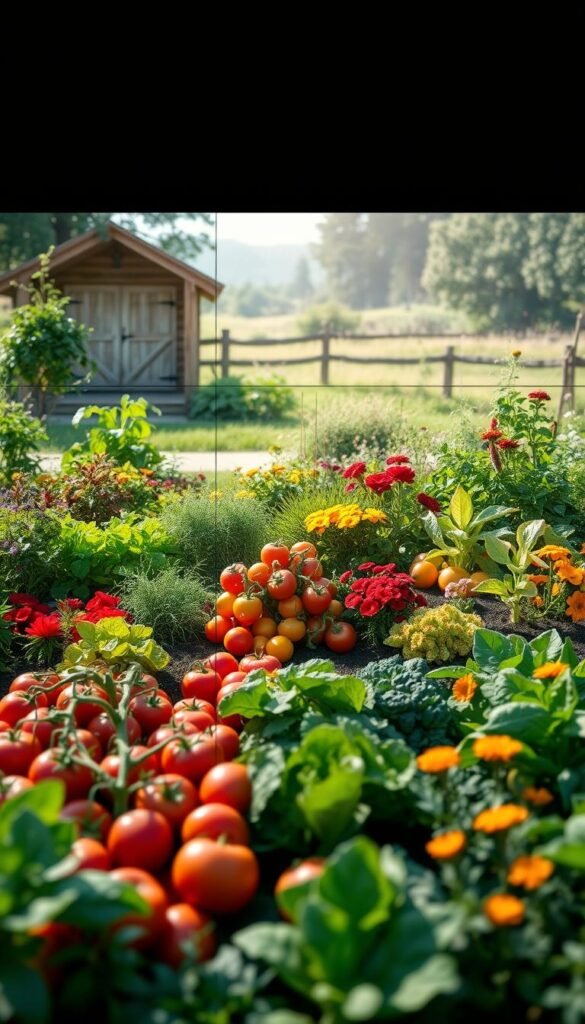
Your garden’s potential lies in smart spatial planning. Start by sketching your available area—even a small balcony can host herbs and dwarf fruit trees. Measure sunlight patterns and note shaded zones to match plants with their ideal conditions.
Mapping Out Your Space for Maximum Yield
Tall crops like pole beans create natural shade for heat-sensitive lettuces. Use vertical space with trellises for cucumbers or strawberries. A 4×4-foot bed can grow 16 different varieties if you stagger heights and growth cycles.
Try this layout for beginners:
| Sun Position | Recommended Plants | Companion Benefits |
|---|---|---|
| Full Sun (6+ hours) | Tomatoes, Peppers | Basil repels aphids |
| Partial Shade | Spinach, Kale | Chives deter cabbage worms |
| Vertical Space | Peas, Nasturtiums | Flowers attract pollinators |
Integrating Companion Planting Techniques
Marigolds aren’t just pretty—their roots secrete chemicals that repel nematodes near tomatoes. This companion planting trick reduces pest issues without sprays. The Three Sisters method (corn, beans, squash) shows how ancient wisdom still works: tall stalks support vines, while broad leaves suppress weeds.
Urban gardener Mia Thompson shares:
“Stacking planters let me grow mint for mojitos above rosemary-roasted potatoes. My 10-foot balcony feeds two people all summer.”
Rotate crops yearly to prevent soil depletion. Pair deep-rooted carrots with shallow lettuce to maximize nutrient uptake. With thoughtful design, your plot becomes a self-sustaining ecosystem where every planting choice serves multiple purposes.
Choosing the Perfect Fruits and Vegetables for Your Garden
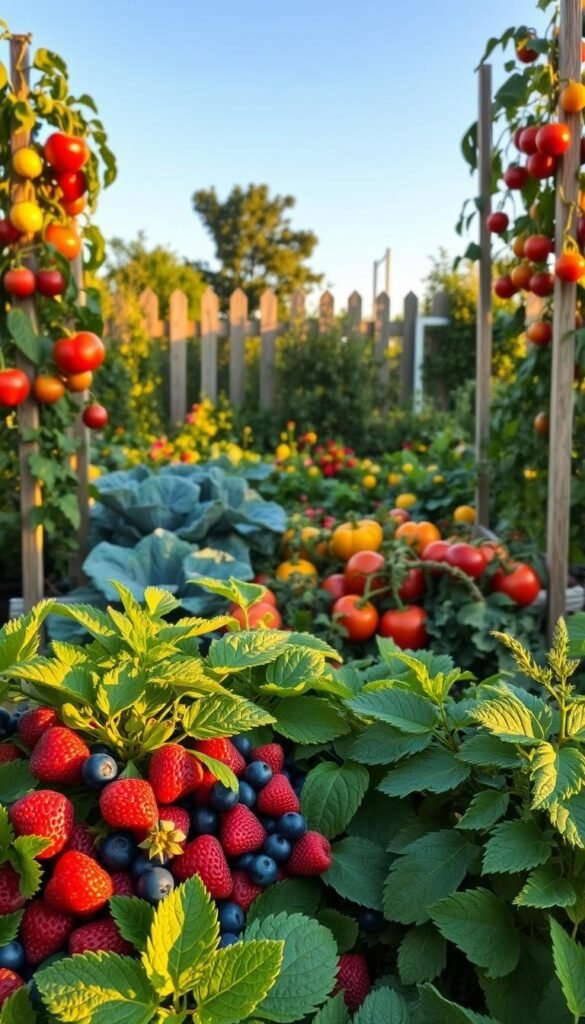
Sunlight stretches longer each day, signaling prime time to curate your edible oasis. Timing matters—selecting the right fruits vegetables for your region ensures juicy rewards. Start by checking your USDA hardiness zone and frost dates to match plants with their ideal growing window.
Seasonal Selections for Spring and Summer
Cool spring soils welcome snap peas and leafy greens. These early starters thrive when temperatures hover between 50-70°F. As heat builds, transition to summer stars like zucchini and cucumbers that soak up warmth.
Try this rotation plan:
| Season | Top Performers | Harvest Timeline |
|---|---|---|
| Spring | Spinach, Radishes | 30-45 days |
| Summer | Eggplant, Peppers | 60-90 days |
Embracing Variety: Tomatoes, Carrots, Berries and More
Cherry tomatoes burst with flavor in containers, while heirloom varieties shine in raised beds. Pair them with carrots—their fern-like leaves mark perfect picking time. For sweetness, everbearing berries yield multiple crops from June through September.
Expand your palette with uncommon finds:
| Unique Pick | Flavor Profile | Uses |
|---|---|---|
| Korean Pears | Crisp, Juicy | Salads, Grilling |
| Red Bartlett Pears | Buttery, Sweet | Desserts, Preserves |
Disease-resistant types like ‘Defiant’ tomatoes reduce headaches for new growers. Mix quick growers (bush beans) with slowpokes (sweet potatoes) for staggered harvests. Your plot becomes a flavor laboratory where every plant earns its place.
Mastering Fruit and Vegetable Garden: Combining Sweet and Savory in One Space
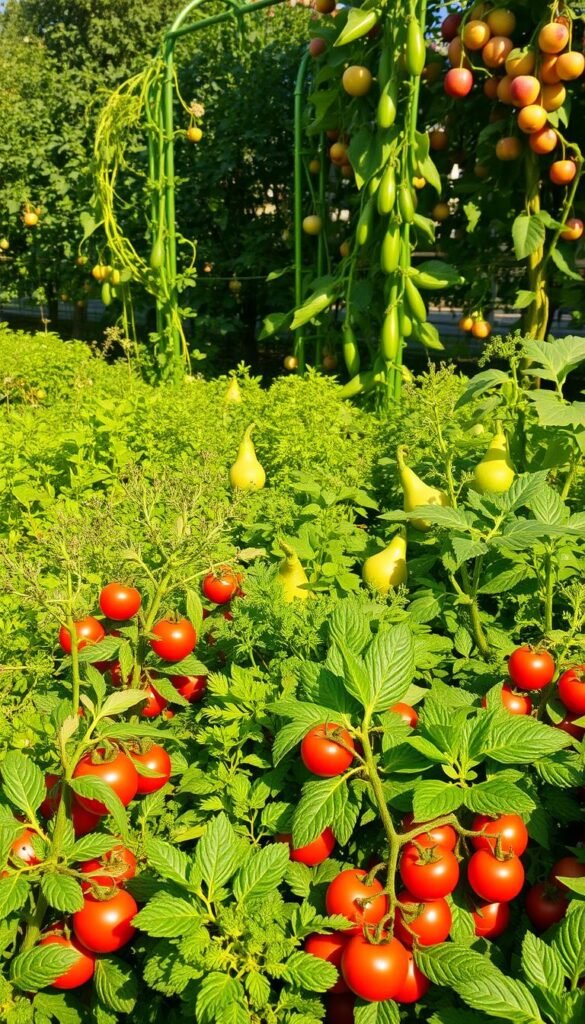
Transform your patch of earth into a flavor powerhouse with smart planning. Success hinges on balancing nature’s rhythms with clever techniques that amplify growth and taste.
Building Foundations for Growth
Start with soil that breathes life into your plants. Mix compost into beds three weeks before planting—this gives microbes time to work their magic. Test drainage by watering deeply: puddles lasting over an hour signal needed amendments like perlite or sand.
Pairing species isn’t just about flavors. Basil releases compounds that shield tomatoes from hornworms, while strawberries deter spinach-eating beetles. Even balcony growers can try this:
| Space-Saving Duo | Benefits | Harvest Window |
|---|---|---|
| Tomato + Basil | Pest control, shared nutrients | 60-85 days |
| Peppers + Marigolds | Nematode prevention | 70-100 days |
Timing Is Everything
Stagger plantings every two weeks for continuous yields. Sow quick-growing radishes between slower carrots—you’ll harvest roots first, giving carrots room to expand. Urban farmer Luis Gomez notes:
“My fire escape boxes produce basil year-round. I start seeds indoors under grow lights six weeks before last frost.”
Mulch with straw after seedlings establish to lock in moisture. Check soil pH monthly; most vegetables fruits thrive between 6.0-7.0. Spot yellow leaves? Add nitrogen-rich fish emulsion.
Rotate crops annually to outsmart diseases. Follow heavy feeders like corn with soil-restorers like beans. With these strategies, your garden becomes a self-sustaining tapestry of tastes.
Handy Tips for Planting and Ongoing Garden Care
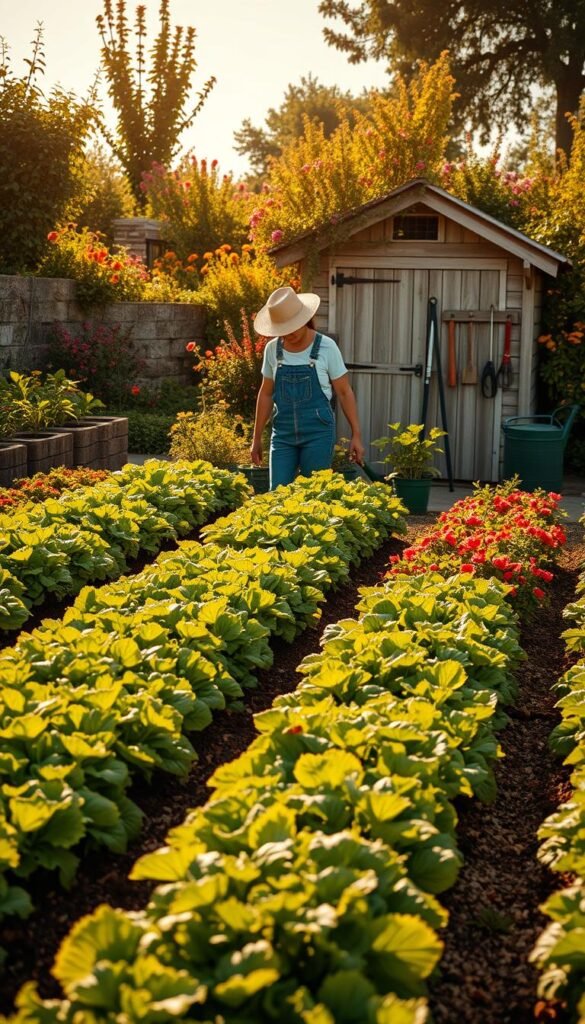
Your morning coffee routine could become garden care time with these efficient strategies. Smart planting choices and simple routines let nature do heavy lifting while you reap rewards.
Simple Steps for Easy Planting
Start with seedlings spaced 12-18 inches apart – tight enough for mutual support, roomy enough for growth. Mix fast-growing radishes with slower carrots; you’ll harvest radishes first, giving carrots space to mature. Companion plants like marigolds reduce pest issues by 40% in USDA trials.
| Planting Tip | Benefit | Time Saver |
|---|---|---|
| Soak pea seeds overnight | Faster germination | 3-5 days earlier sprouts |
| Layer compost under mulch | Slow-release nutrients | 50% less fertilizing |
| Use yogurt containers as cloches | Frost protection | $0 cost solution |
Expert Advice on Daily Garden Maintenance
Master gardener Marie Stone recommends:
“Water deeply before 10 AM – roots drink better when soil’s cool. Check leaves’ undersides weekly; early pest detection prevents infestations.”
Try these easy make-it-work routines:
- Twice-weekly 15-minute walks to spot wilted leaves or ripe produce
- Monthly soil pH checks using $7 test strips from hardware stores
- Compost tea feeding every 14 days for robust plant immunity
Companion plants take care of pests when you pair them strategically. Nasturtiums lure aphids from beans, while dill attracts tomato hornworm predators. This natural approach cuts weeding time by 30% and chemical costs entirely.
Leveraging Local Produce and Seasonal Ingredients
What if your morning harvest could spark conversations at the weekend market? Growing your own ingredients does more than fill your salad bowl—it weaves you into your area’s local food web. Chatting with growers about their heirloom tomatoes might inspire your next planting, while your extra basil becomes a neighbor’s pesto star.
Supporting Local Farmers Through Your Garden
Farmers’ markets aren’t just shopping trips—they’re classrooms. Ask vendors when their season peaks, then plan your garden to fill gaps. Maybe grow spicy arugula in spring before melons arrive, or plant late-season kale when apple orchards bustle. This rhythm creates a year-round feast without overlap.
Join a farm-to-table gathering to swap preservation tricks. Many growers teach canning or fermenting—skills that stretch your harvest into winter. As urban farmer Diego Ruiz notes:
“Trading my pickled carrots for a dairy vendor’s cheese taught me more about flavor balance than any cookbook.”
Your plot becomes a community hub when you share seedlings or host seed swaps. Local gardening clubs often partner with farms for composting programs, turning waste into fertile soil. These connections strengthen food security while building friendships rooted in shared earth.
Need greens in February? Partner with nearby growers through harvest preservation workshops. You’ll enjoy summer’s bounty during frosty months while supporting the farms that nourish your region. Together, you’re crafting a resilient local foodscape—one preserved jar and shared tip at a time.
Delicious Recipes Inspired by Your Garden’s Harvest
Your kitchen counter transforms into a chef’s workstation when garden-fresh ingredients arrive. Vibrant colors and crisp textures invite creativity, turning simple salads into edible art. Let’s explore how to celebrate your homegrown bounty through dishes that highlight nature’s perfect pairings.
Fresh Salads and Savory Dishes Using Garden Produce
Combine peppery arugula with sliced strawberries for a flavor explosion that needs only olive oil and balsamic. Grill zucchini ribbons to add smoky depth to raw kale—heat softens leaves while preserving nutrients. These recipes prove that less prep often means more taste.
Try these winning combinations:
- Chilled watermelon + feta + mint leaves
- Charred corn + cherry tomatoes + lime dressing
- Shaved carrots + toasted almonds + ginger-honey glaze
Integrating Herbs Like Basil for Extra Flavor
Basil does double duty—its aromatic leaves elevate dishes while protecting nearby tomatoes from pests. A 2021 University of Florida study found basil increases tomato yields by 15% when planted together. Tear leaves instead of chopping to preserve essential oils that deliver bold flavor.
| Herb Pairing | Best With | Flavor Boost |
|---|---|---|
| Basil | Tomatoes, Melons | Sweetness enhancer |
| Thyme | Roasted Roots | Earthy undertones |
| Dill | Cucumbers, Potatoes | Fresh crispness |
As chef Elena Martinez advises:
“Massage herbs into dressings 10 minutes before serving—their oils bloom beautifully.”
This technique works wonders with delicateherbslike parsley or cilantro. Yourfoodbecomes a living showcase of your garden’s diversity.
Utilizing Companion Planting for Natural Garden Support
Nature’s perfect partnerships unfold when you pair the right plants together. These alliances create living shields against invaders while boosting your harvests. Let’s explore how strategic placements turn your plot into a self-regulating ecosystem.
How Companion Plants Boost Growth and Deter Pests
French marigolds release a scent that sends whiteflies fleeing from tomatoes. Basil acts as a sacrificial crop, luring aphids away from tender leaves. These companion planting tricks work because they disrupt pests’ navigation systems.
Nasturtiums serve dual purposes. Their vibrant blooms attract pollinators while repelling cucumber beetles. Plant them near beans to create a colorful pest barrier. Garlic chives perform scent-based magic too—their aroma confuses carrot root flies, protecting your crunchy harvest.
| Companion Plants | Protected Crops | Benefits |
|---|---|---|
| Marigolds | Tomatoes | Deters whiteflies |
| Basil | Peppers | Repels thrips |
| Nasturtiums | Cucumbers | Traps aphids |
Master gardener Elena Torres explains:
“Interplanting herbs with vegetables cuts pest damage by 60% in my trials. The basil-tomato duo never fails.”
Edible flowers like calendula add beauty while repelling nematodes. Their petals brighten salads too. This approach creates multiple wins—protection, productivity, and visual appeal.
Rotate your companion plants yearly to maintain soil health. Pair deep-rooted varieties with shallow feeders to maximize nutrient use. With these strategies, your garden becomes a thriving community where every plant plays a vital role.
Enhancing Your Garden’s Visual Appeal
Your edible haven deserves to dazzle the eyes as much as it delights the palate. Strategic design choices turn functional beds into living art, blending colors and textures that pop against green backdrops. Think beyond rows—curved pathways with thyme creeping between stones add whimsy while softening edges.
Design Ideas That Make Your Garden Look as Good as It Tastes
Pair ruby-red tomatoes with emerald basil for a classic combo that looks good on plates and in plots. Their contrasting heights create visual depth—tall tomato stakes behind bushy herbs. Add purple kale or golden marigolds for vibrant splashes that deter pests naturally.
Mix leaf shapes for textural intrigue. Feathery carrot tops dance beside round zucchini leaves, while strawberry runners spill over raised bed edges. Use trellises as focal points, training beans or grapes to climb in artistic patterns. Even practical elements like compost bins become features when bordered with nasturtiums.
Remember: variety isn’t just about flavors. Alternate glossy pepper plants with fuzzy sage, or let mint cascade from hanging baskets above parsley patches. These touches ensure every glance at your garden sparks joy—and maybe a recipe idea or two.





